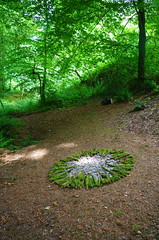Brandon Ballengée is a biological artist, whose researches are revealing that deformities among amphibians are increasing at a frightening rate throughout the world. Not only that, but their populations are declining fast – some already completely vanished. It all seems to have come about just in our own lifetimes.
Brandon brings this phenomenon directly to our attention through his exquisite photographic artworks, and his extensive involvement of members of the public in his biological research . Click the picture.
See also Artful Ecologies
Read Brandon Ballengée’s interview with John K. Grande
And his feature on Green Museum.





very trippy–wow
I knew amphibian pops were declining at horrific rates–I studied at UCSC when Michael Soule was there–but had no idea about these deformities.
LikeLike
Waiting for the video to download – so can’t comment on it yet – but looking forward to seeing it.
By the way have a look at mopsa’s post http://mopsa.blogspot.com/2009/02/mega-spawn.html
she has a picture of some spawn with one egg containing at least 8 separate nuclei. What type of deformity will that produce? Eight conjoined tadpoles – or octuplets?
LikeLike
Lawks!!! Hope no-one minds, i have passed on the link to the North Devon Natural History Network (ndnhn) of which I am a member. They will be interested!
LikeLike
Wow. I haven’t noticed any deformities among amphibians in my neck of the woods… just fewer toads and frogs than 20 years ago, which isn’t a good thing either.
I had read years ago that loss of habitat is more likely a cause of amphibian mutations than toxins in the environment. The loss of habitat causes amphibians to be less able to travel and mate with others outside their immediate gene pool.
Thanks for posting this video. It was VERY interesting. His art work, though disturbing at one level, is also quite beautiful.
LikeLike
The beauty is what makes it disturbing I think. I will ask around our local natural history groups to see what the situation is here.
LikeLike